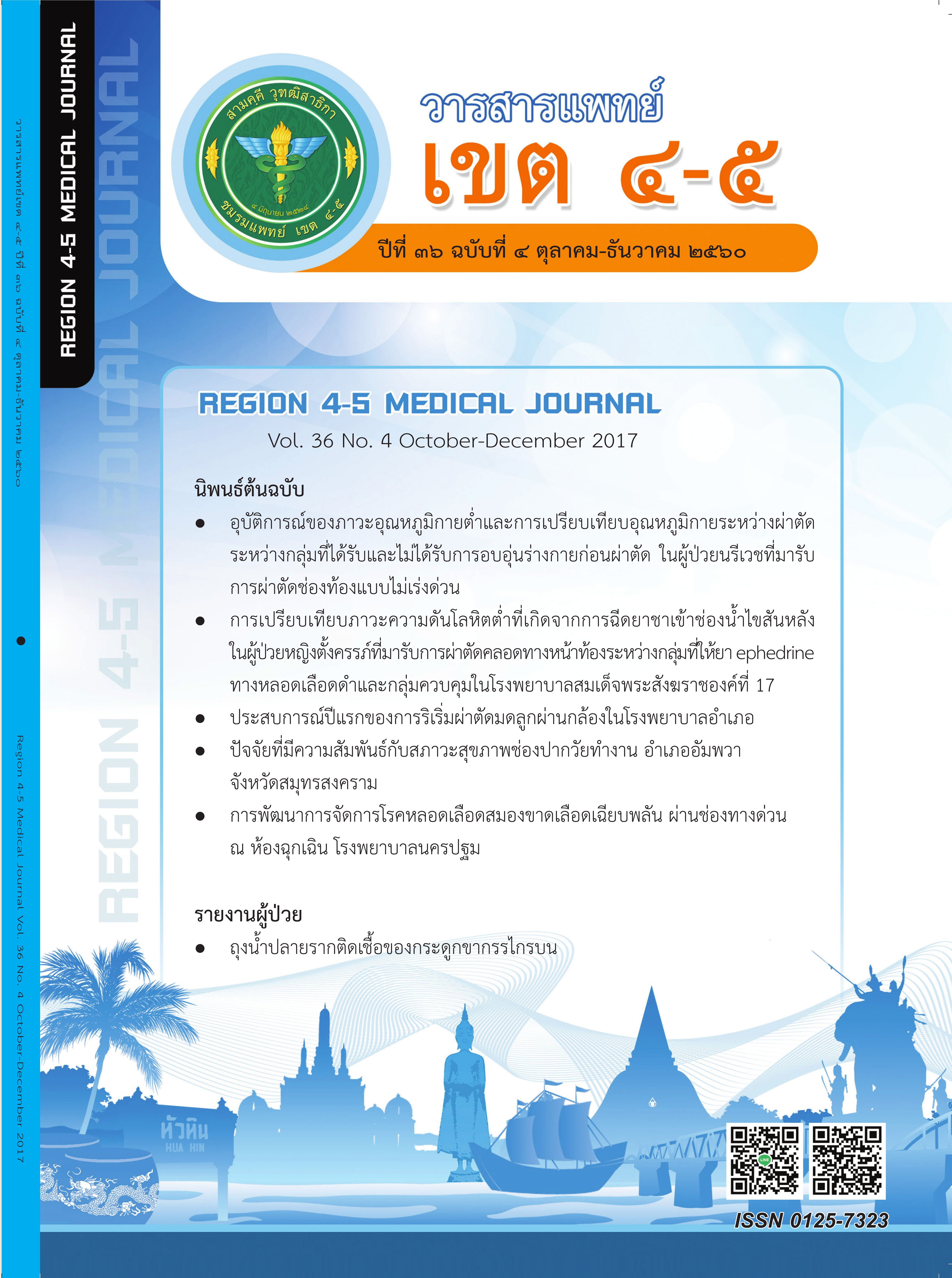การศึกษาคุณลักษณะทางคลินิกและปัจจัยเสี่ยงต่อการเสียชีวิต ของผู้ป่วยโรคปอดติดเชื้อชุมชน ในโรงพยาบาลอู่ทอง จังหวัดสุพรรณบุรี
คำสำคัญ:
โรคปอดติดเชื้อชุมชน, การเสียชีวิต, ปัจจัยเสี่ยง, เครื่องมือประเมินความรุนแรงบทคัดย่อ
โรคปอดติดเชื้อชุมชนเป็นหนึ่งใน 10 สาเหตุการเสียชีวิตมากที่สุดในโรงพยาบาลอู่ทอง และเป็นปัญหาสำคัญของโรงพยาบาล ผู้ป่วยมักมีปัจจัยเสี่ยงต่อการเสียชีวิตต่างกัน และมาด้วยอาการของโรคที่มีความรุนแรงต่างกันการประเมินที่ถูกต้องและครอบคลุมย่อมนำมาซึ่งผลการรักษาที่ดี
วิธีการศึกษา: ศึกษาย้อนหลัง (retrospective study) ในผู้ป่วยที่ได้รับการวินิจฉัยโรคหลักเป็นโรคปอดติดเชื้อชุมชน ตั้งแต่เดือนมิถุนายน 2557 ถึงธันวาคม 2559 ผู้ป่วยจำนวน 270 ราย ผ่านตามเกณฑ์การคัดเข้าและคัดออกแล้ว แบ่งเป็น 2 กลุ่ม คือ รอดชีวิต 220 ราย และเสียชีวิต 50 ราย เก็บข้อมูลและวิเคราะห์ปัจจัยต่างๆ ที่มีผลต่อการเสียชีวิต รวมทั้งประเมิน CURB-65 และ PSI ในผู้ป่วยทั้งสองกลุ่มร่วมด้วย สถิติที่ใช้ในการวิเคราะห์ข้อมูล ได้แก่ ค่าร้อยละ ค่าเฉลี่ย ค่าต่ำสุด ค่าสูงสุด t-test chi-square test และ logistic regression
ผลการศึกษา: พบปัจจัยที่มีความสัมพันธ์กับการเสียชีวิตอย่างมีนัยสำคัญทางสถิติ เช่น การรักษาในห้องไอซียู การติดเชื้อในกระแสเลือด ภาวะช็อกและการหายใจล้มเหลว โดยพบว่าหากผู้ป่วยมีการติดเชื้อในกระแสเลือด ภาวะช็อกและการหายใจล้มเหลว จะมีโอกาสเสียชีวิตมากกว่าคือ 6.85, 9.88 และ 56.31เท่าตามลำดับ เมื่อเทียบกับกลุ่มที่ไม่พบภาวะดังกล่าว (p<0.001) และการเข้ารักษาในห้องไอซียูตั้งแต่แรกรับ ก็พบว่าผู้ป่วยในกลุ่มนี้มีความเสี่ยงต่อการเสียชีวิตมากกว่ากลุ่มที่ไม่ได้เข้ารักษาในห้องไอซียู 5.25 เท่า (95%CI 2.05-13.43: p<0.001) นอกจากนี้ระดับการศึกษาที่ต่ำกว่าระดับมัธยมศึกษาและการใช้ออกซิเจนที่บ้านก็ยังพบความสัมพันธ์ที่มีนัยสำคัญเช่นกัน ส่วนระดับความรู้สึกตัวเปลี่ยนแปลง มีค่า odds ratio 1.36 (p=0.247) ไม่มีนัยสำคัญทางสถิติ
สรุป: ปัจจัยเสี่ยงสำคัญที่อาจมีผลต่อการเสียชีวิต คือ ภาวะติดเชื้อในกระแสเลือด ภาวะช็อก การหายใจ ล้มเหลว และการเข้ารักษาในไอซียูตั้งแต่แรกรับ รวมทั้งประวัติการใช้ออกซิเจนที่บ้านก็อาจเป็นปัจจัยเสี่ยงของการเสียชีวิต การประเมินโดยใช้ CURB-65 score และ PSI มีประโยชน์เพื่อใช้ประเมินความเสี่ยงของผู้ป่วยโรคปอดติดเชื้อชุมชนในบริบทของโรงพยาบาลอู่ทอง
เอกสารอ้างอิง
2. Mandell LA, Wunderink RG, Anzueto A, et al. Infectious Diseases Society of America/American Thoracic Society consensus guidelines on the management of community-acquired pneumonia in adults. Clin Infect Dis 2007;44 Suppl 2:S27-72.
3. Uematsu H, Kunisawa S, Sasaki N, et al. Development of a risk-adjusted in-hospital mortality prediction model for communityacquired pneumonia: a retrospective analysis using a Japanese administrative database. BMC Pulm Med 2014;14:203.
4. Yang Y, Xu F, Shi LY, et al. Efficacy and significance of various scores for pneumonia severity in the management of patients with community-acquired pneumonia in China. Chin Med J (Engl) 2012;125:639-45.
5. Sirvent JM, Carmen de la Torre M, Lorencio C, et al. Predictive factors of mortality in severe community-acquired pneumonia: a model with data on the first 24h of ICU admission. Med Intensiva 2013;37:308-15.
6. Neupane B, Walter SD, Krueger P, et al. Predictors of in-hospital mortality and re-hospitalization in older adults with community-acquired pneumonia: a prospective cohort study. BMC Geriatr 2010;10:22.
7. Yeon Lee S, Cha SI, Seo H, et al. Multimarker Prognostication for Hospitalized Patients with Community-acquired Pneumonia. Intern Med 2016;55:887-93.
8. Walden AP, Clarke GM, McKechnie S, et al. Patients with community acquired pneumonia admitted to European intensive care units: an epidemiological survey of the GenOSept cohort. Crit Care 2014;18:R58.
9. Akram AR, Chalmers JD, Taylor JK, et al. An evaluation of clinical stability criteria to predict hospital course in communityacquired pneumonia. Clin Microbiol Infect 2013;19:1174-80.
10. Hirata Y, Tomioka H, Sekiya R, et al. Association of hyperglycemia on admission and during hospitalization with mortality in diabetic patients admitted for pneumonia. Intern Med 2013;52:2431-8.
11. Braun E, Kheir J, Mashiach T, et al. Is elevated red cell distribution width a prognostic predictor in adult patients with community acquired pneumonia? BMC Infect Dis 2014;14:129.
12. Adrie C, Schwebel C, Garrouste-Orgeas M, et al. Initial use of one or two antibiotics for critically ill patients with community-acquired pneumonia: impact on survival and bacterial resistance. Crit Care 2013;17:R265.
13. Singanayagam A, Singanayagam A, Chalmers JD. Obesity is associated with improved survival in community-acquired pneumonia. Eur Respir J 2013;42:180-7.
14. Asadi L, Sligl WI, Eurich DT, et al. Macrolidebased regimens and mortality in hospitalized patients with community-acquired pneumonia: a systematic review and metaanalysis. Clin Infect Dis 2012;55(3):371-80.
15. Mortensen EM, Pugh MJ, Copeland LA, et al. Impact of statins and angiotensinconverting enzyme inhibitors on mortality of subjects hospitalised with pneumonia. Eur Respir J 2008;31:611-7.
16. Mortensen EM, Restrepo MI, Anzueto A, et al. The effect of prior statin use on 30-day mortality for patients hospitalized with community-acquired pneumonia. Respir Res 2005;6:82.
17. Majumdar SR, McAlister FA, Eurich DT, et al. Statins and outcomes in patients admitted to hospital with community acquired pneumonia: population based prospective cohort study. BMJ 2006;333:999.
ดาวน์โหลด
เผยแพร่แล้ว
รูปแบบการอ้างอิง
ฉบับ
ประเภทบทความ
สัญญาอนุญาต
ลิขสิทธิ์บทความเป็นของผู้เขียนบทความ แต่หากผลงานของท่านได้รับการพิจารณาตีพิมพ์ลงวารสารแพทย์เขต 4-5 จะคงไว้ซึ่งสิทธิ์ในการตีพิมพ์ครั้งแรกด้วยเหตุที่บทความจะปรากฎในวารสารที่เข้าถึงได้ จึงอนุญาตให้นำบทความในวารสารไปใช้ประโยชน์ได้ในเชิงวิชาการโดยจำเป็นต้องมีการอ้างอิงถึงชื่อวารสารอย่างถูกต้อง แต่ไม่อนุญาตให้นำไปใช้ในเชิงพาณิชย์




